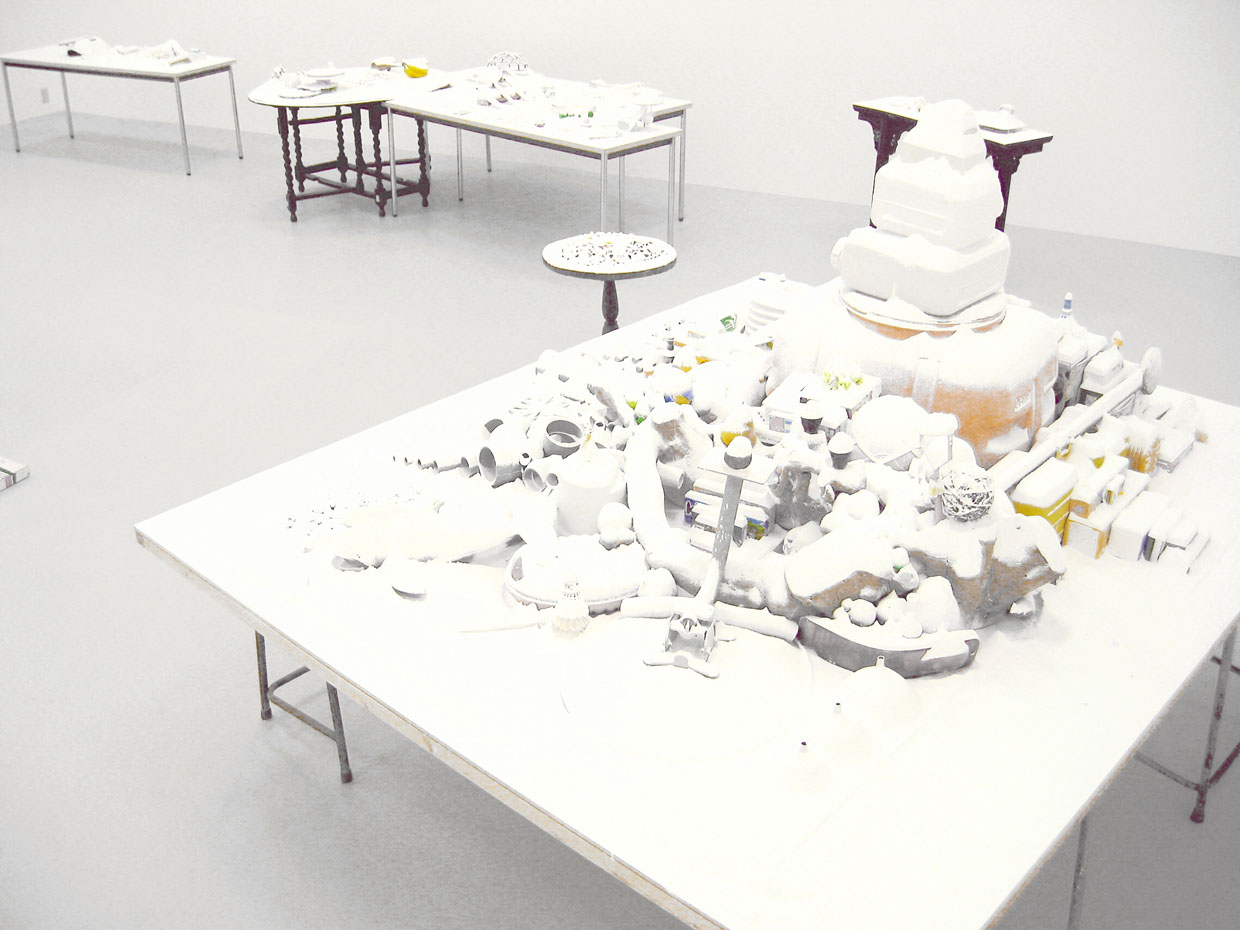With a show titled "Ways of Worldmaking," you expect something big and with plenty of diversity — and The National Museum of Art, Osaka, mostly achieves this. Six individuals and three artist groups — all young and up-and-coming — have been brought together and given large, immersive spaces in which visitors can wander around and wonder.
Arguably the most attractive work is Ryota Kuwakubo's "The Tenth Sentiment" (2011), and this is partly because he creates so much from so little. Viewers walk into a blacked-out hall and watch a light source attached to a model train that moves by and around objects arranged on the floor. The items appear to be nothing more than upside-down sieves, cotton reels, pegs and the bits and bobs from children's toys. The shadows they create on the gallery walls, however, become constantly changing vistas. One moment you appear to be whizzing through a modern cityscape of high rises; the next, you're in the countryside going by electrical towers. To viewers deprived of any other visual information in the darkness, the simplicity of the imagery and its ghostliness suggest something almost latently subconscious.
Another of the artists creating distinctively powerful visual work is Yasuaki Onishi. "Reverse of Volume" (2011) recalls something of the aesthetic concept of "the sublime": It opens up to a vastness of scale and seeming formlessness. Coarse threads suspend billowing sheets of material from the ceiling, and as you walk beneath them the feeling is something akin to floating in a landscape void of gravity.
Ryoko Aoki and Zon Ito's collaborative piece — the title of which still pending — shows the artists creating much the same as they have been for some years now. Aoki is known for "scribbled" drawings and jottings accompanied by usually unrelated diaristic commentary that leave meanings elusive and fragmentary. Ito does a similar kind of thing in embroidery, and while the fragments of imagery can often be suggestive, they never really congeal into anything specific. In the present work, the same pictorial conventions have been transferred into animation, though nothing much new from the artists emerges.
The same can be said for the art duo paramodel's installation "paramodelic — grafitti" (2011). Yasuhiko Hayashi and Yusuke Nakano have created vast networks of graffiti-style lines and designs over walls, ceiling and floor using their customary medium of Plarail, the blue toy-railway track made by Tomy. Through basically repeating themselves, however, paramodel have hit upon a formula that pleases the most in all their iterations to date.
Another art duo, exonemo — artists Kensuke Senbo and Yae Aikawa — take to the world of the Internet and the rapid rise of information technology. The two once made a painting of the Google Web browser search page, and the Internet giant subsequently purchased it.
While exonemo can do interesting things — for example, their "FragMental Storm for iPhone" (2009), in which a Web word-search results in a collage of images and texts that gets out of control — "Got, Exists" (2009/10) and "Got is Dead" (2011) are a little dull when viewed in a gallery context. There is not much to see apart from a ring of laptops on the floor, and search requests on the Internet for "Got" rather than "God" seems more of a spelling error than something profound.
The show rounds off with the psychedelic spinning color disks of Kengo Kito; a snowscape-like installation titled "Black Map" by Teppei Kaneuji — the type he has become well known for — as well as his nesting acrylic boxes with colorful optical-illusionary surface-line work; and geometric tile designs that have been painted over by Masanori Handa (b.1979).
While "Ways of Worldmaking" is full of the engaging and intriguing, the catalog does little to foster a better understanding of the show.
One issue is that it does not, for the most part, document the works on display but focuses on the artists' earlier bodies of work.
The unrelated catalog essays are another issue. The opening essay, for example, is about cosmogony, Albert Einstein, Friedman equations, the inflationary universe and quantum mechanics. Other essays follow cultural narratives found in Christianity, medieval scholasticism, and Japanese cultural myths from in the ancient scripts of the "Kojiki" and "Nihon Shoki." These appear to have no practical or conceptual application to the works on display.
If a conceptual formulation for world-making is indeed necessary, it might be better found in the words of the late-19th-century art historian Alois Riegl, who in 1902 attempted to define man's relationship to the world: "By means of art," he wrote, an artist or anyone else, "seeks another world which is its own free creation, to put beside the world which was none of his making."
"Ways of Worldmaking"at The National Museum of Art, Osaka, runs yillDec. 11; admission ¥850; open 10 a.m.- 5 p.m. (Fri. till 7 p.m.), closed Mon. For more information, visit www.nmao.go.jp.

















With your current subscription plan you can comment on stories. However, before writing your first comment, please create a display name in the Profile section of your subscriber account page.